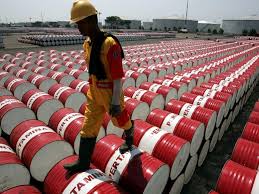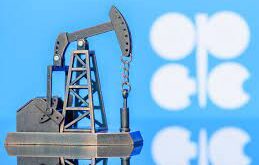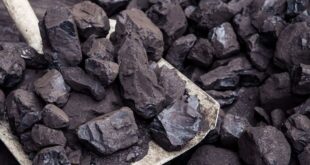The two most critical forecasts of global oil markets offer contrasting visions for 2018: one in which OPEC finally succeeds in clearing a supply glut. and another where that goal remains elusive.
In the estimation of the Organization of Petroleum Exporting Countries. production curbs by the cartel and its allies will finally eliminate the excess oil inventories that have depressed crude prices for more than three years. But in the view of the International Energy Agency (IEA). which advises consumers. that surplus will barely budge.
“Both cannot be right.“ said Ole Sloth Hansen. head of commodity strategy at Saxo Bank A S in Copenhagen. “Whichever way the pendulum swings will have a significant impact on the market.“
OPEC and Russia have eliminated almost two-thirds of a global glut this year as the former rivals jointly constrict their crude production to offset a boom in U.S. shale oil. At the heart of the clash between the 2018 forecasts is whether the alliance can deplete the rest of the overhang without triggering a new flood of American shale.
Late last year. OPEC and Russia set aside decades of rivalry and mistrust to end a slump in global oil markets that has battered their economies. Defying widespread skepticism. they cut oil supplies as promised. and resolved on Nov. 30 to persevere until the end of next year. Brent crude climbed this week to a two-year high above $65 bbl. although prices had slipped to $63.37 as of 11:32 a.m. in London.
Both the IEA and OPEC agree that the coalition’s cuts are working. The surplus oil inventories in developed nations — OPEC’s main metric for gauging success — fell to 111 MMbbl in October. from 291 million last November. according to the Paris-based IEA. established in 1974 in the wake of the Arab oil embargo.
Happy New Year?
Where they diverge is on what happens next. OPEC predicts the re-balancing will be complete by late next year as those stockpiles plunge by about 130 MMbbl in 2018. By contrast. the IEA sees inventories remaining steady as new supply growth surpasses gains in demand. It warned OPEC on Thursday that it may be deprived of a “Happy New Year.“
Although both institutions project that demand for OPEC crude will be about 32.3 MMbpd on average in the first half of 2018. their views drift apart as the year progresses. OPEC expects it will need to pump about 34 million barrels day in the second half. while the IEA sees a requirement of just 32.7 MMbpd.
“They live in the same world for the first half of 2018. but divorce into separate universes for the second half.“ said Olivier Jakob. managing director at consultants Petromatrix GmbH in Zug. Switzerland. “OPEC believes in strong growth of oil demand. the IEA believes in strong growth of non-OPEC supplies.“
Diverging views
While OPEC expects rival supplies to expand by 1 MMbpd next year. the IEA forecasts non-OPEC to grow by 1.6 MMbpd. The difference partly lies in their conflicting views of the supply source that unleashed the glut OPEC is now battling to clear: U.S. shale oil. OPEC boosted estimates for U.S. crude production this week and now sees an expansion of 720.000 bpd next year. Still. the IEA’s forecast is about 20% higher.
“The uncertainty surrounding shale oil production for next year has resulted in very differing views on the 2018 fundamental picture.“ said Tamas Varga. an analyst at PVM Oil Associates Ltd. in London.
When OPEC officials invited a range of experts to brief them on the U.S. shale outlook days before their Nov. 30 meeting. they were dismayed by the divergence of opinions. people familiar with the matter said. One of those experts. veteran crude trader Andy Hall. cited the unpredictability of shale as one reason for shuttering his flagship hedge fund this summer.
Shale limits
Saudi Arabian Minister of Energy and Industry Khalid Al-Falih. speaking at the OPEC meeting in Vienna. rejected the IEA’s outlook for 2018 as excessively pessimistic.
There are signs that the U.S. shale boom is slowing. Drillers may have reached the limits in terms of cutting costs and boosting productivity. and investors are finally insisting that profits are shared out rather than funneled back into supply growth.
Yet analysts from Citigroup Inc. to Goldman Sachs Group Inc. and Commerzbank AG warn that OPEC continues to underestimate the magnitude of the shale revolution.
American producers are rushing to lock in revenues as U.S. crude approaches $60 a barrel. enabling them to finance a new wave of drilling. data compiled by Bloomberg New Energy Finance show.
“The U.S. alone can achieve almost all of the supply growth that OPEC forecasts globally in 2018.“ said Carsten Fritsch. an analyst at Commerzbank in Frankfurt. “So. without question. the IEA’s forecast is more convincing.“

 Iran Energy News Oil, Gas, Petrochemical and Energy Field Specialized Channel
Iran Energy News Oil, Gas, Petrochemical and Energy Field Specialized Channel



